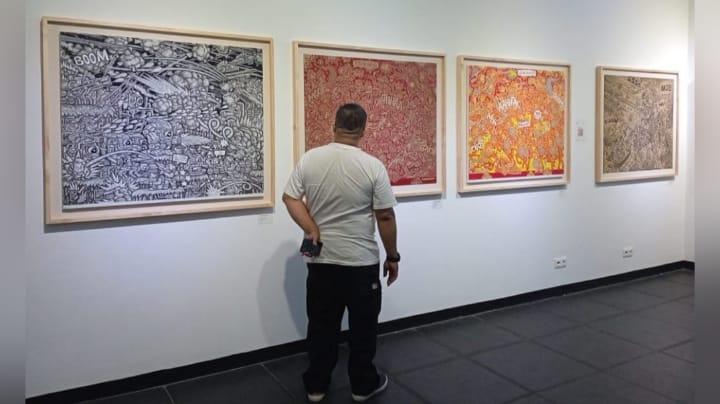
Robert Draws – Bali artist I Kadek Septa Adi is holding a solo exhibition titled Horns and Cannons at Hybridium Gallery, Lawangwangi Creative Space, Bandung. The exhibition runs from June 14 to July 17, 2024. In this showcase, Septa combines Balinese traditional painting with graphic art techniques. “I use graphic techniques to take lines from traditional Balinese paintings,” said Septa on Friday, June 14, 2024.
All of the artworks featured in the exhibition were created using the lino cut technique. The images are carved into lino rubber plates, then printed onto canvas. After printing, the images are hand-colored on the canvas. Additionally, Septa also displays the prints of the images he created. “This shows the artist’s skills,” explained Andonowati, the Director of ArtSociates, during the opening of the exhibition.
The lino cut technique, which involves carving and printing, allows for bold lines and shapes that reflect the traditional Balinese style while introducing the modern graphic art medium. This fusion of techniques creates a unique visual impact. The combination of traditional Balinese symbols with modern artistic expression brings new life to the art form.
“Read about: Jean Pecasse’s Artworks Donated to ARMA Museum Ubud”
Septa’s works feature objects such as cannons, missiles, tanks, and fighter jets. These images symbolize not only human intelligence but also a threat to traditional lifestyles that have existed for centuries. By contrasting the cannon, a symbol of modern technology, with horns representing tradition, Septa explores the tension between these two forces. The images are presented in a comic style, adding a contemporary twist to the traditional subject matter.
The artist’s depiction of modern warfare, presented in a playful yet intense manner, reflects his concern about the impact of technology on culture. The comic-style approach allows the viewer to engage with serious themes through a more accessible lens. This combination of lightheartedness and gravity draws attention to the urgency of preserving tradition while navigating modernity.
Curator Axel Ridzky notes that Septa reflects on the current events surrounding his life and the world. The artist’s reaction to global news, especially concerning war, is evident in his works. Through his graphic art, Septa conveys the tension of ongoing conflicts while channeling the anti-war sentiment of the famous artist Pablo Picasso. This influence is apparent in his artwork, which echoes fragments of Picasso’s renowned 1937 painting, Guernica.
According to Ridzky, the imagery in Septa’s work brings the viewer into a chaotic, comical war scene. The explosions, clashes, and crashes are set against a backdrop of landscapes typical of Balinese painting. The viewer is invited into a surreal, intense world where the traditional meets the modern in a striking visual dialogue. This approach challenges the conventional boundaries of art while addressing relevant social and political issues.
“Read more: Fishing Tips and Tricks: Mastering Your Favorite Outdoor Activity”
Septa’s use of both modern graphic techniques and traditional Balinese themes creates a bridge between past and present. His works often feature symbolic imagery, such as horns and cannons, that reflect the ongoing clash between modern technological advances and the preservation of cultural heritage. By blending these elements, Septa’s artwork creates a conversation between different times and ideologies.
The use of Balinese traditional motifs in his work is not only a tribute to his heritage but also a way to question the effects of modern life on these traditions. In contrast, the graphic elements provide a contemporary framework for exploring these issues. The combination allows viewers to see the relevance of traditional art in today’s fast-paced, technology-driven world.
Septa’s unique approach is gaining recognition for its innovative take on traditional art forms. His ability to incorporate graphic design into traditional painting makes his work accessible to a wider audience. It also demonstrates the potential for artistic expression to evolve while maintaining respect for cultural roots.
As the exhibition continues, Septa’s works are capturing the attention of art lovers and critics alike. His fusion of traditional painting with modern graphic design creates a new artistic language that speaks to both local and global audiences. The exhibition offers a fresh perspective on Balinese art while encouraging conversations about technology, tradition, and the future of culture.
Septa’s dedication to merging two distinct art forms is helping to push the boundaries of what art can be. His works provide a platform for exploring deep societal issues in a visually dynamic and thought-provoking manner. As his influence continues to grow, the Bali artist is paving the way for a new generation of artists who are willing to experiment and innovate.